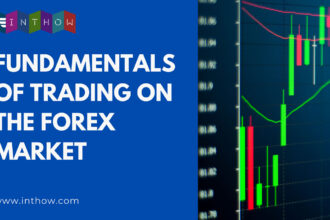Order flow is an older concept that has always been used to anticipate price fluctuations in financial markets. However, retail traders were unable to use this concept as they could not access the details about market orders in the earlier days. Modern traders are at an advantage due to technological advancements, which allow them to access more relevant information to learn and understand the concept of order flow. Because of this, traders have started to see this concept in a new light and have started using it well to make informed trading decisions. In this article, you will learn about order flow in forex trading and how you can use it to improve your trading techniques.
Basis of Forex Trading and Order Flow
When you engage in forex trading, you must place orders for buying and selling the trading instruments at the best price levels. Your profitability as a trader greatly depends on the price at which your order is executed. The order flow in the trading is the actual buying and selling activity in the market. Each and every retail trader or institution that places an order for either buying or selling specific trading instruments, which are currency pairs in the context of forex, is actually contributing towards the order flow.
So, we can say that the entire forex market remains active as long as traders place new orders. In other words, the order flow must keep the market alive and functional. The absence of orders will indicate that the market is stuck, and this also suggests a state of stagnation if it goes on for a longer duration. The concept of order flow is also closely related to the trading volume.
When the order flow is at an optimum level, the market will have a high trade volume, and traders will also be able to place orders more easily due to the increased liquidity. A change in order flow or decrease in trading activity results in lower trade volume, insufficient liquidity and fewer trading opportunities as there are not enough buyers and sellers in the market. One cannot place a buy order unless someone on the other end is ready to sell the instrument. For every buyer, there should be a seller and vice versa. Hence, the concept of order flow.
What Does Order Flow Tell Us About the Market?
Now, we have understood the concept of order flow in forex trading, but what does it tell us about the market, and why is it relevant for traders? As we said earlier, order flow tells us about the orders that are being placed in the market, and it also shows the direction in which the market is moving, whether it’s trending or ranging. If it is trending, you can also use the order flow information to measure the trend’s strength. The support and resistance levels in price charts are also influenced by the order flow that is there for the trading instrument.
As you may already know, banks are the most prominent market participants in forex, and half of the trading volume comes from them. So, the interbank market plays a key role in this aspect as they are the primary contributors in the order flow of the currency market as well. As we said earlier, order flow is not just about the price movements or exchange rate fluctuations but also about the volume of trade, which gives us a clearer picture of the trading activities.
In short, order flow information lets you see the market with a wider perspective. Being a forex trader, you cannot expect to make profits by focusing on your trades alone because you have to follow the market to make the most out of your trades. You can use different trading calculators to calculate different aspects of the trade, such as position size, leverage, pip value, P&Ls and more. This will give you a better idea of when to enter and exit a trade and how much profit or loss to book.
How Do You Get Order Flow Information as a Retail Forex Trader?
Now, one question that will rise in your mind as a retail forex trader is how you can access order flow information in real time. It was not that easy in the past, but popular trading platforms like MT4 have made it readily available for all users with the powerful ‘Depth of Market’ feature. The ‘Depth of Market’ feature lets you see the number of buy and sell orders placed for each price level in a trading instrument. So, when you choose a currency pair for trading, you can simply open the DOM chart and see all the relevant order flow information there.
The number of orders and the type of orders priced at a particular price level can be used to assess the strength of trading activity. It tells us whether more buying or selling is happening for a specific price. If you see more buy orders placed at a price level than sell orders, the probability of a price rise is quite high. The chances of the price going down are considered high when there are more sell orders than buy orders placed at a particular price level.
Traders with an account on the MT4 platform can easily use the Depth of Market feature to access order flow information. MT4 is a beginner-friendly platform, but it also offers many powerful features and tools, making it the most popular trading software among forex traders. So, If you don’t have an account, you can simply sign up for one by choosing a suitable broker offering MT4 as their trading platform and get started with MT4 trading.
Beginners should also use the demo account functionality of MetaTrader 4 to learn and practise in real-time market conditions without being exposed to market risk. Forex demo accounts are also a perfect place for those who want to test their strategies or just test the trading conditions their chosen broker offers before opening a live trading account.
Connection between Market Order and Market Depth and Their Impact
A market order is an order that gets placed and executed at the current market price. When you place a market order, it is immediately executed in real-time at the best market price. It differs from a pending order, where you get to ensure that it will only be executed at a specific price level or it will get cancelled. So, the market orders that are placed around the time of the currency pair reaching a particular price have a higher chance of getting executed, while the pending orders placed for a particular trade may get cancelled if there are no matching orders at that level or the price doesn’t exactly reach that level.
The problem with the Depth of Market feature or Market Depth data is that it shows all the orders placed for a price. This will also include orders that get cancelled before they are filled. So, an order being placed does not guarantee its execution. The data will not change after the cancellation of orders as it only tells that a trader placed the order at some point. It tells us about the market sentiment and what kind of price movements are being expected by the majority of traders. So, you cannot assume that all the orders placed for a price level get executed; hence, we cannot predict the price movements based on order flow alone.
How Do You Use Order Flow Information in Actual Trading?
As we mentioned earlier, you cannot make trading decisions based on Order flow alone, but it can certainly be used to confirm your trades. For instance, if you were considering opening a long position in a currency pair, you can check the order flow or market depth and proceed with the trade if there are more buyers at the price level you chose for entering the trade.
A large number of buy orders can indicate the overall market sentiment is bullish. If there are more sell orders at a price level, then you may take it as a bearish signal, making it appropriate for shorting. You can also use order flow data to determine support and resistance levels, as an increased level of buying or selling activity at a level indicates the formation of a solid support or resistance level.
Conclusion
To sum it up, learning about order flow and using the depth of the market feature will be useful for an average forex trader trying to enhance their trading skills. You can use it as a powerful tool in your decision-making process.









